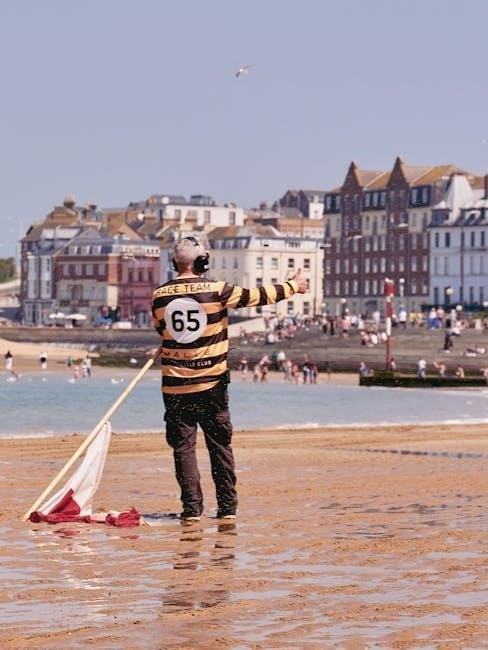case backhoe serial number and year guide pdf
This guide provides essential information for identifying Case backhoe models and manufacturing years using serial numbers. It covers models like the 580, 580B, and 580C, helping users decode serial number formats to determine production years and ensure proper maintenance and part compatibility.
Understanding serial numbers is crucial for accurate repairs, ordering parts, and maintaining equipment performance. This guide offers a comprehensive breakdown of serial number structures, year identification, and model differentiation, ensuring users can optimize their machinery effectively.
1.1 Overview of the Importance of Serial Numbers
Serial numbers are crucial for identifying and maintaining Case backhoes, serving as unique identifiers for each machine. They provide essential information about the model, production year, and specific components, which is vital for ordering correct replacement parts and ensuring compatibility. Additionally, serial numbers help in verifying the authenticity of equipment, preventing theft, and facilitating warranty claims. They also play a key role in tracking maintenance history and complying with manufacturer recommendations, ultimately contributing to the longevity and performance of the machinery.
1.2 Purpose of the Guide
This guide is designed to help users decode and understand Case backhoe serial numbers, enabling accurate identification of models, production years, and specifications. It serves as a comprehensive resource for determining equipment age, ensuring proper maintenance, and ordering compatible parts. The guide also aids in verifying authenticity and optimizing performance, while helping users navigate the complexities of serial number formats. By providing clear, structured information, it empowers owners and technicians to manage their machinery effectively, ensuring reliability and longevity of their Case backhoes through precise identification and maintenance practices.

How to Locate the Serial Number on Your Case Backhoe
Serial numbers on Case backhoes are typically found on the frame, engine housing, or near the operator’s seat. Check the left side of the dash or under the left door for older models. For newer models, look on the instrument panel or toolbox. Refer to your model-specific manual or contact an authorized dealer for precise locations, ensuring accurate identification and verification of your equipment.
2.1 Serial Number Location for Different Models
The serial number location varies across different Case backhoe models. For older models like the 580B and 580C, the serial number is often found on the left side of the dash or under the left door on the frame. Newer models, such as the 580K and 580L, typically have the serial number on the instrument panel or near the steering column. For the 580K, it is also located on the left side of the steering column. Always refer to the specific model’s manual or contact an authorized dealer for precise location details to ensure accurate identification.
2.2 Common Locations for Serial Number Plates
Serial number plates on Case backhoes are typically found in consistent locations across models. The most common areas include the instrument panel, frame, or engine housing. For many models, the plate is mounted on the left side of the dash, near the steering column, or inside the left door of the cab. Some models also place the serial number on the toolbox or near the operator’s seat. These locations ensure easy access for identification purposes. Always consult the operator’s manual or contact an authorized dealer for model-specific guidance to locate the serial number plate accurately.
2.3 Decoding the Serial Number Format
Decoding the serial number format is essential for identifying the model and year of your Case backhoe. Older models (1988–2003) typically have 7–8 digit serial numbers, while newer models (2004–present) use 9–10 digits, with the second digit representing the year of manufacture. The format varies by model series, but most include a prefix, production year code, and unique identifier. For example, serial numbers starting with “17” often indicate specific production periods. Understanding the structure helps in accurately determining the model, production year, and compatibility of parts. Always cross-reference with official Case documentation or consult a dealer for precise decoding.

Understanding the Structure of Case Backhoe Serial Numbers
Case backhoe serial numbers contain a unique combination of digits, with older models (1988–2003) using 7–8 digits and newer models (2004–present) using 9–10 digits. The structure includes a prefix, production year code, and unique identifier, helping determine the model and manufacturing year. This format aids in accurate part ordering and maintenance planning.
3.1 Breakdown of Serial Number Components
Case backhoe serial numbers are structured into distinct components, including a prefix, model codes, and a production year identifier. Older models (1988–2003) feature 7–8 digits, while newer models (2004–present) use 9–10 digits, with the year often embedded as the second digit. The prefix identifies the model series, such as “580” or “680,” while subsequent digits denote production details. Unique identifiers ensure each machine’s specificity. This breakdown helps users decode their serial number to determine the model, manufacturing year, and maintenance requirements, ensuring compatibility when ordering parts or scheduling repairs.
3.2 Significance of Each Digit in the Serial Number
Each digit in a Case backhoe serial number holds specific meaning. The initial digits often represent the model series, such as “580” or “680,” identifying the machine type. Subsequent digits encode production details, including manufacturing year and unique identifiers. The second digit in newer models (2004-present) typically denotes the year, while older models (1988-2003) use a different format. Understanding each digit’s role aids in accurately identifying the model, production year, and maintenance requirements, ensuring compatibility when ordering parts or scheduling repairs. This precise structure helps users decode their serial number effectively for optimal equipment management.
3.3 Year Identification Within the Serial Number
Identifying the manufacturing year within a Case backhoe serial number involves decoding specific digits. For models produced from 2004 onwards, the second digit in the serial number signifies the year. For example, a serial number starting with “17” indicates a 2017 model. Older models, such as those from 1988 to 2003, use a different format, often requiring reference guides or manufacturer resources to decode. Accurate year identification ensures proper maintenance scheduling, parts compatibility, and compliance with service recommendations, enhancing overall equipment performance and longevity.

Case Backhoe Serial Number Patterns by Year
Case backhoe serial numbers follow distinct patterns, with older models (1988-2003) using 7-8 digits and newer models (2004-present) using 9-10 digits, including a year code.
4.1 Serial Number Ranges for Specific Years
Case backhoe serial numbers are organized into ranges that correspond to specific production years. For example, models from 1988-2003 typically have 7-8 digit serial numbers, while 2004-present models use 9-10 digits, with the year embedded as the second digit. Certain series, like the 580K, have serial numbers starting with “17” for 1988 production. These ranges help users identify the exact year and model, ensuring accurate maintenance and parts compatibility. By cross-referencing these ranges, owners can determine their backhoe’s production year and model specifications effectively.
4.2 Year-Specific Serial Number Prefixes
Case backhoe serial numbers often include year-specific prefixes that help identify the production year. For example, models manufactured in 1988 may have serial numbers starting with “17,” while older models from the early 1970s might begin with “8650001.” These prefixes vary by series and production era, providing a quick reference for determining the age of the equipment. By analyzing these prefixes, users can match their backhoe’s serial number to the correct year and model, ensuring accurate identification and maintenance. This system simplifies the process of decoding serial numbers for owners and technicians alike.
4.3 Evolution of Serial Number Formats Over the Years
Case backhoe serial number formats have evolved significantly over the years, reflecting changes in manufacturing and documentation standards. Early models (pre-1988) typically used shorter, 7-8 digit serial numbers without embedded year codes. Starting in 1988, serial numbers began with specific prefixes like “17” for the K series. From 2004 onward, formats shifted to 9-10 digits, incorporating the production year as the second digit. This progression from basic to detailed encoding has improved traceability and maintenance efficiency, helping users accurately identify and service their equipment; Understanding this evolution is key to decoding and applying serial number information effectively.

Identifying the Model Using the Serial Number
Case backhoe models like 580CK, 580B, and 580C can be identified by decoding the serial number, which contains specific prefixes and digits corresponding to model designations. This guide helps users map serial numbers to exact models, ensuring accurate identification for maintenance and parts compatibility.
5.1 Mapping Serial Numbers to Specific Models
By analyzing the serial number’s structure, users can map it to specific Case backhoe models. For instance, the 580CK, 580B, and 580C series have unique prefixes within their serial numbers, allowing precise model identification. This method ensures accurate part ordering and maintenance, avoiding compatibility issues. The guide details how each digit or character corresponds to a particular model, enabling users to cross-reference effectively. This process is vital for maintaining equipment performance and longevity, ensuring operators can quickly identify their model for any service or repair needs.
5.2 Distinguishing Between Different Backhoe Series
Different Case backhoe series, such as the 580B, 580C, and 580K, can be distinguished by specific patterns in their serial numbers. For example, the 580B series often starts with unique prefixes, while the 580C series follows a distinct numerical sequence. By analyzing these patterns, users can identify the exact series of their backhoe, ensuring accurate maintenance and repairs. This method also helps in ordering the correct replacement parts, as each series may have unique components. The guide provides detailed cross-referencing tools to help users pinpoint their backhoe’s series quickly and efficiently, avoiding costly mismatches and ensuring optimal performance.
5.3 Cross-Referencing Serial Numbers with Model Specifications
Cross-referencing serial numbers with model specifications ensures accurate identification of your Case backhoe’s make, model, and year. By using detailed guides or official Case resources, you can match your serial number to specific model details, confirming the exact specifications and production year. This process is essential for ordering correct parts, ensuring proper maintenance, and verifying equipment authenticity. It also helps in understanding the unique features and capabilities of your backhoe, optimizing its performance and longevity. Regular cross-referencing is a proactive step to maintain your machinery’s value and operational efficiency.

Determining the Manufacturing Year
Case backhoe serial numbers encode the manufacturing year, with older models (1988-2003) using 7-8 digits and newer models (2004-present) using 9-10 digits, including the year as the 2nd digit.
6.1 Using the Serial Number to Identify Production Year
Decoding the serial number is key to determining the production year of your Case backhoe. Older models (1988-2003) feature 7-8 digit serial numbers, while newer models (2004-present) use 9-10 digits, with the year embedded as the second digit. For example, a serial number starting with “17” indicates a 2017 model. This method ensures accurate identification, crucial for maintenance, repairs, and ordering compatible parts. Always cross-reference with official Case documentation for precise year determination.
6.2 Decoding the Year Code in the Serial Number
Decoding the year code within the serial number involves identifying specific digits that represent the production year. For Case backhoes, the year code is typically embedded within the serial number sequence. For example, a serial number starting with “17” indicates the machine was produced in 2017. Variations exist across models, so consulting official Case documentation or contacting authorized dealers is essential for accurate decoding. This step ensures proper maintenance scheduling and parts ordering, avoiding costly mismatches. Always verify the year code against Case resources to guarantee precision.
6.3 Verifying the Year with Case Manufacturer Resources
Verifying the year of your Case backhoe using official manufacturer resources ensures accuracy. Case IH provides detailed serial number databases and product identification guides. By cross-referencing your serial number with these resources, you can confirm the production year. Additionally, authorized Case dealerships offer lookup services to decode serial numbers and provide year-specific information. For precise results, use official documentation or contact Case support directly. This step is crucial for ensuring compatibility with parts and maintenance schedules, avoiding potential errors from generic decoding methods. Always rely on verified manufacturer resources for accurate year identification.

Common Mistakes to Avoid When Decoding Serial Numbers
Common mistakes include misinterpreting digits, overlooking the year code, and assuming all models follow the same pattern. Always verify with official Case resources or authorized dealers.
7.1 Misinterpreting Serial Number Digits
Misinterpreting serial number digits is a common error. For instance, confusing the production year digit with other codes can lead to incorrect model identification. Always cross-reference with official guides to avoid this mistake.
7.2 Overlooking the Year Code Position
One common mistake is overlooking the position of the year code within the serial number. For Case backhoes, the year is often embedded as a specific digit or letter, varying by model and production year; For example, in older models (1988-2003), the year may appear as the second digit, while in newer models (2004-present), it is integrated differently. Failing to identify the correct position can lead to misidentification of the manufacturing year, potentially causing errors in ordering parts or determining maintenance schedules. Always consult official guides or manufacturer resources to ensure accurate decoding.
7.3 Assuming All Models Follow the Same Pattern
A common error is assuming all Case backhoe models follow the same serial number pattern. However, different models and series, such as the 580, 580B, and 580C, have distinct serial number structures. For instance, older models (1988-2003) use 7-8 digit serial numbers, while newer models (2004-present) use 9-10 digits with the year embedded as the second digit. Additionally, series like the 580K and 580L may have unique formats. This variation means users must consult model-specific guides or contact authorized dealers to avoid misidentification and ensure accuracy in determining the year and model of their equipment.

Resources for Further Assistance
For further guidance, refer to official Case IH documentation, online forums, and authorized dealerships. These resources provide detailed serial number databases, model specifications, and expert support for accurate identification and maintenance.
8.1 Official Case IH Documentation and Guides
Official Case IH documentation provides comprehensive guides for decoding serial numbers and identifying backhoe models. These resources include detailed serial number databases, model specifications, and year identification charts, ensuring accuracy for maintenance and repairs. The guides are available through the Case IH website or authorized dealerships, offering a reliable source for owners and technicians. They also include contact information for customer support and access to specialized software for serial number analysis;
By referencing these official materials, users can confidently decode their backhoe’s serial number to determine its production year, model series, and specific features, ensuring proper part compatibility and optimal performance.
8.2 Online Forums and Communities for Support
Online forums and communities are invaluable resources for Case backhoe owners seeking guidance on serial number decoding. Platforms like Reddit, tractor forums, and Facebook groups host discussions where experienced operators and technicians share insights. These communities often provide crowdsourced information, including serial number breakdowns, model identification tips, and year verification methods. Users can post their serial numbers for expert analysis or browse existing threads for similar queries. Additionally, these forums offer a space to exchange knowledge, troubleshoot issues, and connect with enthusiasts who can provide practical advice and support.
Engaging with these communities ensures access to real-world experiences and solutions, complementing official documentation with peer-to-peer insights.

8.3 contacting Authorized Case Dealerships
8.3 Contacting Authorized Case Dealerships
Reaching out to authorized Case dealerships is a reliable way to obtain accurate information about your backhoe’s serial number and manufacturing year. Dealerships have access to official databases and manufacturer records, ensuring precise decoding of serial numbers. They can also provide detailed specifications, parts compatibility, and maintenance recommendations tailored to your model. To get started, locate your nearest Case dealership through their official website or customer service. Be prepared to provide your serial number for a quick lookup. This direct approach guarantees authoritative insights, helping you maintain your equipment effectively and ensure compliance with manufacturer standards.

The Importance of Accurate Serial Number Identification
Accurate serial number identification ensures proper maintenance, correct part ordering, and maintains equipment value. It guarantees compatibility, optimizes performance, and extends machinery lifespan.
9.1 Ensuring Proper Maintenance and Repairs
Accurate serial number identification is critical for proper maintenance and repairs. It ensures that technicians use compatible parts and procedures, preventing costly errors and potential equipment damage. By decoding the serial number, users can access accurate service manuals, diagnostic tools, and genuine replacement parts tailored to their specific model. This precision minimizes downtime and ensures repairs are performed safely and effectively, maintaining the machine’s performance and longevity. Proper maintenance also enhances safety, as incorrect repairs can lead to operational failures and accidents.
9.2 Ordering the Correct Replacement Parts
Accurate serial number identification ensures the correct replacement parts are ordered for your Case backhoe. Using the wrong parts can lead to equipment damage, safety risks, and increased maintenance costs. By decoding the serial number, users can determine the exact specifications of their machine, ensuring compatibility with OEM or aftermarket parts. This avoids costly errors and downtime. Always verify part numbers with official Case documentation or authorized dealers to guarantee fitment and performance. Proper part selection maintains equipment reliability, safety, and operational efficiency, extending the lifespan of your Case backhoe.
9.3 Maintaining Equipment Value and Performance
Accurate serial number identification is vital for maintaining your Case backhoe’s value and performance. Correct part compatibility ensures optimal functionality, preventing damage from ill-fitting components. Regular maintenance, guided by accurate serial number data, preserves the machine’s efficiency and longevity. Proper upkeep enhances resale value, as potential buyers seek well-maintained equipment. Additionally, identifying the correct year of manufacture helps in accessing tailored service recommendations, ensuring your backhoe operates at peak performance. By leveraging serial number insights, you protect your investment and maintain operational excellence, ensuring your Case backhoe remains reliable and productive for years to come.
This guide provides a comprehensive approach to understanding Case backhoe serial numbers, enabling accurate year identification, model verification, and proper maintenance, ensuring optimal equipment performance and longevity.
10.1 Summary of Key Points
This guide provides a detailed approach to understanding Case backhoe serial numbers, focusing on their structure, year identification, and model differentiation. Key points include the importance of serial numbers for maintenance, repairs, and part compatibility, as well as how to decode them to determine production years and model specifics. The guide also highlights common mistakes to avoid, such as misinterpreting digits or assuming uniform patterns across models. By following the outlined steps, users can accurately identify their equipment’s year and model, ensuring proper care and optimal performance. Additional resources, like official guides and forums, are recommended for further assistance.
10.2 Final Tips for Using the Serial Number Guide
Always verify the serial number location on your specific Case backhoe model before decoding. Cross-reference your findings with official Case documentation or authorized dealers for accuracy. Double-check each digit to avoid misinterpretation, as small errors can lead to incorrect year or model identification. Utilize online forums and communities for additional support, but rely on official resources for critical decisions. Keep this guide handy for future reference and share it with others who may benefit. By following these tips, you’ll maximize the effectiveness of your serial number guide and ensure your equipment operates at its best.





























